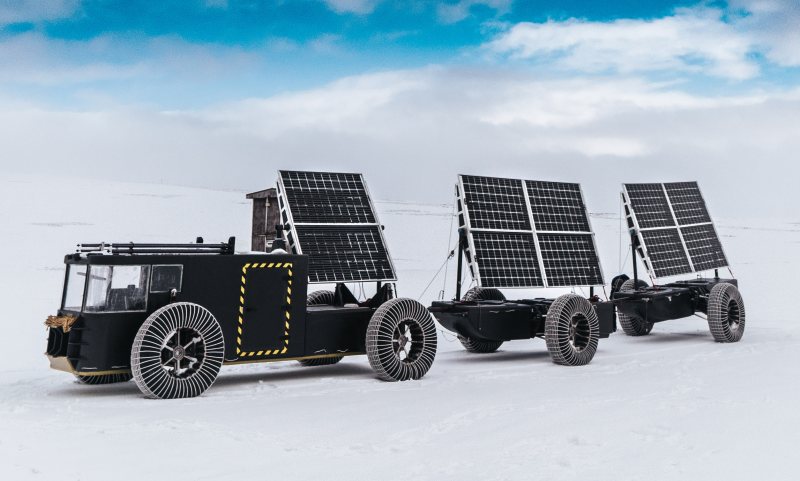
Image: Clean2Antarctica
Built in part using plastic waste and powered by the sun, the Solar Voyager will begin its journey to the South Pole towards the end of this month.
Inspired by polar travelers Marc Cornelissen and Wilco van Rooijen who floated the idea of travelling to the geographical South Pole in an all-terrain solar powered vehicle constructed primarily from recycled plastic waste, the Netherlands’ Edwin ter Velde picked up the concept and ran with it. In just a few weeks he and his wife Liesbeth will start their adventure in the Solar Voyager.
The body of the vehicle consists of “hexcores” – a light and strong honeycomb-shaped building block. The hexcores are made from recycled plastic pellets sourced from a waste plant that were melted to create a filament that fed forty 3D printers.
16 metres in total length (including trailers), Solar Voyager features 10 bifacial solar panels of 325 Watts capacity each. The panels measure 99 x 175cm and weigh about 25kg each. It can get a little breezy in Antarctica, so the panels can be pulled down during adverse conditions.
While it has a 10kWh battery bank, this is only for emergency situations. It is expected the bulk of the journey will be powered directly by the sun, made possible by long daylight hours at this time of the year – there are a couple of weeks around late December when the sun doesn’t set.
The vehicle has a carbon fibre skin with the belly of it also coated in Twarwon, a material used in bullet-proof vests, that will help protect the underside from sharp ice ridges. The tyres on Solar Voyager are essentially just heavy- duty inner tubes covered with Endumax netting.
Weighing in just shy of 1.5 tonnes, the vehicle will have a maximum speed of 8 kmh.
The trailers bearing the solar panels will also act as food lockers, carrying enough sustenance for the pair for 47 days. They’ll need to eat a lot. Due to the conditions, energy intake required is 31,380 kilojoules – a day. There will be more than 200 kg of food carried on the Solar Voyager.
Under the banner of Clean2Antarctica, the goal of the journey is to raise awareness of issues surrounding waste and promote the transition to a circular society.
The team will be arriving at Union Glacier on the 26th of November and final preparations will take 2 days. The goal is to complete the 2,300 kilometer journey within 30 days. Edwin and Liesbeth will be accompanied by a small support team travelling separately who will only intervene in an emergency situation. The primary task of the support team is to record the journey.
You’ll be able to keep up with the Clean2Antarctica team’s progress on the organisation’s blog.

 RSS - Posts
RSS - Posts



Speak Your Mind